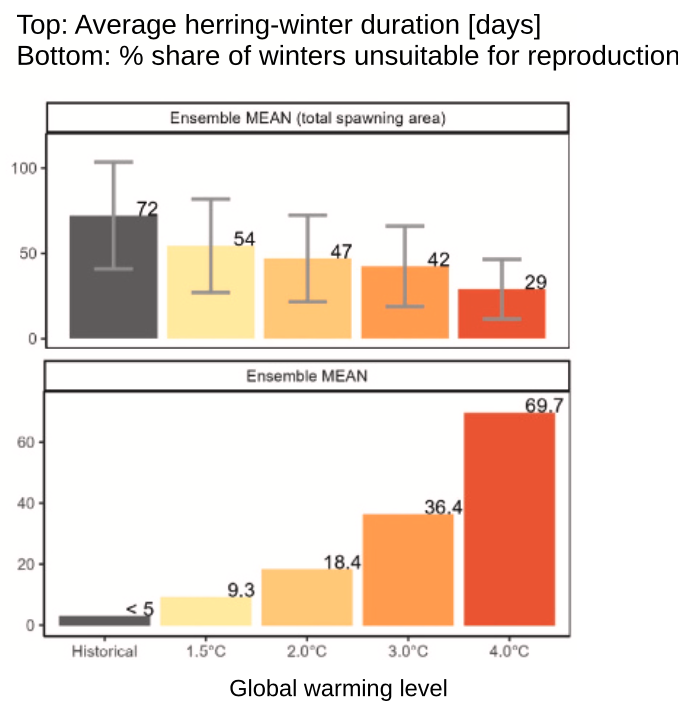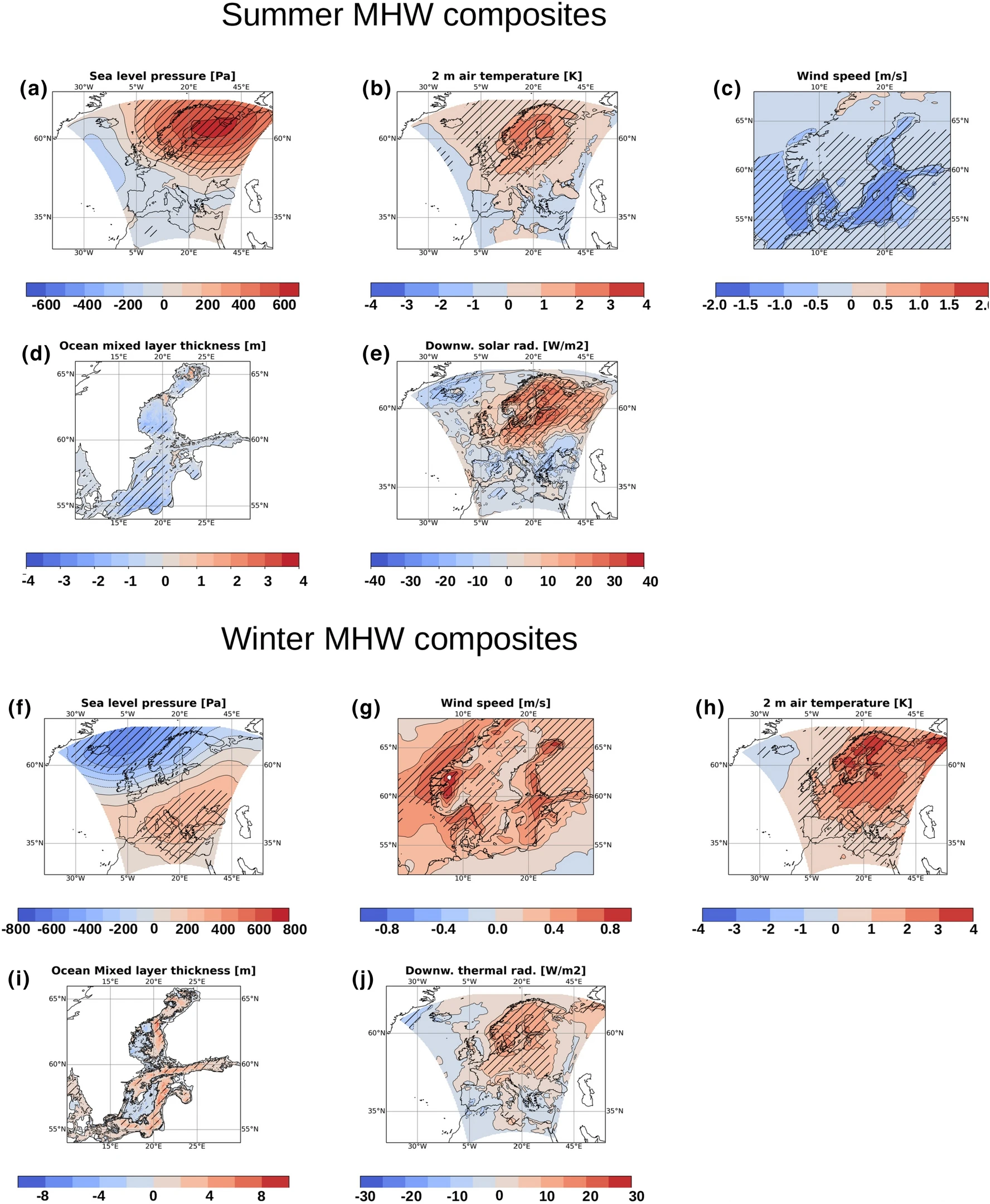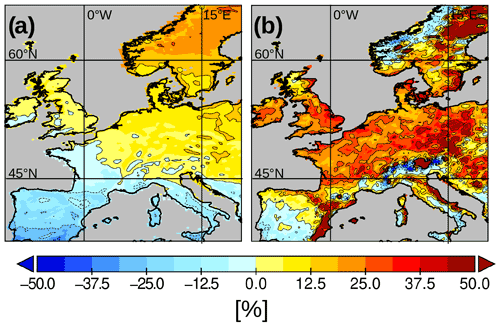
How Marine heatwaves and climate change impacts on western Baltic Sea herring habitats
The western Baltic Sea herring population is one of the most important economic fish stocks in the Baltic Sea. The population experienced a dramatic decrease in course of previous decades and consequently herring catches droped from almost 200.000 t to roughly 25.000 t in recent years. It has been hypothesized that climate change, more precisely the anomalous warm winters contributed to this decline besides continously ongoing high rates of industrial fishing. Recent field investigations from the Greifswald Bay, one of the most imortant spawning site for herring, revealed a clear statistical relationship between winter length, defined as the period in which shallow waters remain below 3.5 °C, and hering recruitment. Consequently, the timing of winter inception in autumn, and winter termination in in spring plays a major role for the herrings reproductive succes. Projections of ocean climate were then used to elaborate how climete change under assumption of different climate targets from the The United Nations Framework Convention on Climate Change (UNFCC) Paris 2015 Agreement will change the winter characteristice in future.

Hence, in more and more spawning locations, winter length will successively decline and in the worst case winters suitable for successful reproduction won't occur anymore. In a global world 4 °C warmer compared to the preindustrial state, up to 60 % of local winter occurences may be vanished. However, climate scenarios compliant with the Paris Agreement 2015 to limit global warming below 2.0°C or even 1.5 °C will mitigate the effect on winter climate considerably.
original study:
Gröger, M., F. Börgel, S. Karsten, H. E. M. Meier, K. Safonova, C. Dutheil, A. Receveur and P. Polte (2024). Future climate change and marine heatwaves - Projected impact on key habitats for herring reproduction. Sci. Total Environ. 951: 175756, doi: 10.1016/j.scitotenv.2024.175756. https://www.sciencedirect.com/science/article/pii/S0048969724059126
Recent research -- Drivers of marine heatwaves
Drivers of Marine Heat Waves in the Baltic Sea
The latest assessent of Climate Change in the Baltic Sea region spots the Baltic Sea among the fastest marginal seas in the World Ocean (Meier et al., 2022). Moreover, extreme sea surface tempertatures have shown to rise faster than mean temperatures in this region in response to climate change (Gröger et al., 2022). Therefore, the liklihood for marine heat waves will increase. Consequently, there is strong demand to investigate the processes that drive the development of MHWs. For this, the meteorological conditions over the 5, 15 , and 30 days before the maximum MHW extend at the sea surface, have been investigated. The figure below shows mean conditions for 15 days.
In a recent study these drivers could be identified with help of model hindcast simulations over 37 year of the historical past (Gröger et al., 2024). It was found that MHWs in the summer season are controlled by lopcal meteorological conditions that favor a stable blocking of Scandinavia (Figure a). Associated with this is an strong High pressure system with elevated air tempartures and anomalous strong solar radiation. In addition, calm wind conditions reduce the mixing of surface water with cold water from depth. Overall, this provides positive feedbacks to trigger extraordinary warm surface waters.

MHWs during winter are controlled by extraordinary heat advection from the North Atlantic to Europe. The heat advection reduces cooling of the sea surface that takes place during winter. These conditions are favored when an increased sea level pressure gradient between the Icelnadic Low pressure system and central/southern Europe occur that drive anomalously high winds.
original study:
Gröger, M., Dutheil, C., Börgel, F., Meier, HEM (2024): Drivers of marine heatwaves in a stratified marginal sea, Climate Dynamics,7062, DOI:10.1007/s00382-023-07062-5
Previous research -- Atmospheric Rivers
Atmospheric Rivers are small elongated corridors of anomalous high atmopsheric moisture transport. They can drive hazardous precipitation often paralleled by intense flooding. Studies from the global CMIP5, and CMIP6 suite clearly indicate that the risk for AR induced precipitation will increase in a future warmer climate.This result is in accordance with the expexted thermodynamical response to climate warming. For the local pattern of heavey precipitation, however, dynamical changes, such as systematic changes in the routing of atmospheric rivers over the continent represent an additional source of uncertainty at the local scale.
![]()
Atmospheric river associated with storm Lothar after Christmas 1999. Left analyzed from ERA-interim data. Right: downscaled with a regional high resolution climate model Shown is the vertically integrated atmospheric moisture transport
In the study a suite of CMIP5 global models were downscaled to a resolution 0f 0.22°. It was found that over most of Europe river-induced precipitation rates increased more than mean precipitation rates (figure below). Only over the Iberian Peninsula and the western coast of Norway river induced precipitation rates were lower in a future warmer climate. The lower rates over Norway were attributed to a change in the route rivers take over Europe. In the future climate the majority of ARs are routed more from southern Europe to the north while the potion arriving directly from the North Atlantic diminished. Accordingly ARs travel longer distances over the continent which reduces their moisture content. In southern Europe river induced precipitation as well as mean precipitation rates lower, but the lowering in mean rates is stronger.

original study: